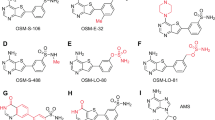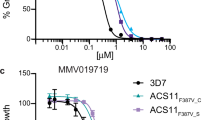Abstract
Malaria is an infectious disease caused by parasites of the genus Plasmodium, which leads to approximately one million deaths per annum worldwide. Chemical validation of new antimalarial targets is urgently required in view of rising resistance to current drugs. One such putative target is the enzyme N-myristoyltransferase, which catalyses the attachment of the fatty acid myristate to protein substrates (N-myristoylation). Here, we report an integrated chemical biology approach to explore protein myristoylation in the major human parasite P. falciparum, combining chemical proteomic tools for identification of the myristoylated and glycosylphosphatidylinositol-anchored proteome with selective small-molecule N-myristoyltransferase inhibitors. We demonstrate that N-myristoyltransferase is an essential and chemically tractable target in malaria parasites both in vitro and in vivo, and show that selective inhibition of N-myristoylation leads to catastrophic and irreversible failure to assemble the inner membrane complex, a critical subcellular organelle in the parasite life cycle. Our studies provide the basis for the development of new antimalarials targeting N-myristoyltransferase.
This is a preview of subscription content, access via your institution
Access options
Subscribe to this journal
Receive 12 print issues and online access
$259.00 per year
only $21.58 per issue
Buy this article
- Purchase on Springer Link
- Instant access to full article PDF
Prices may be subject to local taxes which are calculated during checkout






Similar content being viewed by others
References
Murray, C. J. L. et al. Global malaria mortality between 1980 and 2010: a systematic analysis. Lancet 379, 413–431 (2012).
Price, R. N. et al. Vivax malaria: neglected and not benign. Am. J. Trop. Med. Hyg. 77, 79–87 (2007).
Phyo, A. P. et al. Emergence of artemisinin-resistant malaria on the western border of Thailand: a longitudinal study. Lancet 379, 1960–1966 (2012).
Wright, M. H., Heal, W. P., Mann, D. J. & Tate, E. W. Protein myristoylation in health and disease. J. Chem. Biol. 3, 19–35 (2009).
Ebiike, H. et al. Design and synthesis of novel benzofurans as a new class of antifungal agents targeting fungal N-myristoyltransferase. Part 2. Bioorg. Med. Chem. Lett. 12, 607–610 (2002).
Frearson, J. A. et al. N-myristoyltransferase inhibitors as new leads to treat sleeping sickness. Nature 464, 728–732 (2010).
Tate, E. W., Bell, A. S., Rackham, M. D. & Wright, M. H. N-Myristoyltransferase as a potential drug target in malaria and leishmaniasis. Parasitology, available on CJO2013. http://dx.doi.org/doi:10.1017/S0031182013000450 (2013).
Traverso, J. A., Giglione, C. & Meinnel, T. High-throughput profiling of N-myristoylation substrate specificity across species including pathogens. Proteomics 13, 25–36 (2013).
Moskes, C. et al. Export of Plasmodium falciparum calcium-dependent protein kinase 1 to the parasitophorous vacuole is dependent on three N-terminal membrane anchor motifs. Mol. Microbiol. 54, 676–691 (2004).
Rees-Channer, R. R. et al. Dual acylation of the 45 kDa gliding-associated protein (GAP45) in Plasmodium falciparum merozoites. Mol. Biochem. Parasitol. 149, 113–116 (2006).
Russo, I., Oksman, A. & Goldberg, D. E. Fatty acid acylation regulates trafficking of the unusual Plasmodium falciparum calpain to the nucleolus. Mol. Microbiol. 72, 229–245 (2009).
Rahlfs, S. et al. Myristoylated adenylate kinase-2 of Plasmodium falciparum forms a heterodimer with myristoyltransferase. Mol. Biochem. Parasitol. 163, 77–84 (2009).
Struck, N. S. et al. Plasmodium falciparum possesses two GRASP proteins that are differentially targeted to the Golgi complex via a higher- and lower-eukaryote-like mechanism. J. Cell Sci. 121, 2123–2129 (2008).
Resh, M. D. Trafficking and signaling by fatty-acylated and prenylated proteins. Nature Chem. Biol. 2, 584–590 (2006).
Gunaratne, R. S. et al. Characterization of N-myristoyltransferase from Plasmodium falciparum. Biochem. J. 348, 459–463 (2000).
Pino, P. et al. A tetracycline-repressible transactivator system to study essential genes in malaria parasites. Cell Host Microbe 12, 824–834 (2012).
Limenitakis, J. & Soldati-Favre, D. Functional genetics in Apicomplexa: potentials and limits. FEBS Lett. 585, 1579–1588 (2011).
Heal, W. P. & Tate, E. W. Getting a chemical handle on protein post-translational modification. Org. Biomol. Chem. 8, 731–738 (2010).
Hang, H. C. & Linder, M. E. Exploring protein lipidation with chemical biology. Chem. Rev. 111, 6341–6358 (2011).
Heal, W. P., Wickramasinghe, S. R., Leatherbarrow, R. J. & Tate, E. W. N-Myristoyl transferase-mediated protein labelling in vivo. Org. Biomol. Chem. 6, 2308–2315 (2008).
Heal, W. P., Wright, M. H., Thinon, E. & Tate, E. W. Multifunctional protein labeling via enzymatic N-terminal tagging and elaboration by click chemistry. Nature Protoc. 7, 105–117 (2012).
Charron, G. et al. Robust fluorescent detection of protein fatty-acylation with chemical reporters. J. Am. Chem. Soc. 131, 4967–4975 (2009).
Hannoush, R. N. & Arenas-Ramirez, N. Imaging the lipidome: omega-alkynyl fatty acids for detection and cellular visualization of lipid-modified proteins. ACS Chem. Biol. 4, 581–587 (2009).
Yap, M. C. et al. Rapid and selective detection of fatty acylated proteins using omega-alkynyl-fatty acids and click chemistry. J. Lipid Res. 51, 1566–1580 (2010).
Goncalves, V. et al. Discovery of Plasmodium vivax N-myristoyltransferase inhibitors: screening, synthesis, and structural characterization of their binding mode. J. Med. Chem. 55, 3578–3582 (2012).
Bhatnagar, R. S. et al. Structure of N-myristoyltransferase with bound myristoylCoA and peptide substrate analogs. Nature Struct. Biol. 5, 1091–1097 (1998).
Heal, W. P. et al. Bioorthogonal chemical tagging of protein cholesterylation in living cells. Chem. Commun. 47, 4081–4083 (2011).
Green, J. L. et al. The motor complex of Plasmodium falciparum: phosphorylation by a calcium-dependent protein kinase. J. Biol. Chem. 283, 30980–30989 (2008).
Gerold, P., Schofield, L., Blackman, M. J., Holder, A. A. & Schwarz, R. T. Structural analysis of the glycosyl-phosphatidylinositol membrane anchor of the merozoite surface proteins-1 and -2 of Plasmodium falciparum. Mol. Biochem. Parasitol. 75, 131–143 (1996).
Arumugam, T. U. et al. Discovery of GAMA, a Plasmodium falciparum merozoite micronemal protein, as a novel blood-stage vaccine candidate antigen. Infect. Immun. 79, 4523–4532 (2011).
Gilson, P. R. et al. Identification and stoichiometry of glycosylphosphatidylinositol-anchored membrane proteins of the human malaria parasite Plasmodium falciparum. Mol. Cell Proteom. 5, 1286–1299 (2006).
Lin, H., Su, X. & He, B. Protein lysine acylation and cysteine succination by intermediates of energy metabolism. ACS Chem. Biol. 7, 947–960 (2012).
Cabrera, A. et al. Dissection of minimal sequence requirements for rhoptry membrane targeting in the malaria parasite. Traffic 13, 1335–1350 (2012).
Kimura, A., Kato, Y. & Hirano, H. N-Myristoylation of the Rpt2 subunit regulates intracellular localization of the yeast 26S proteasome. Biochemistry 51, 8856–8866 (2012).
Li, H. et al. Validation of the proteasome as a therapeutic target in Plasmodium using an epoxyketone inhibitor with parasite-specific toxicity. Chem. Biol. 19, 1535–1545 (2012).
Haste, N. M. et al. Exploring the Plasmodium falciparum cyclic-adenosine monophosphate (cAMP)-dependent protein kinase (PfPKA) as a therapeutic target. Microbes Infect. 14, 838–850 (2012).
Rached, F. B. et al. Construction of a Plasmodium falciparum Rab-interactome identifies CK1 and PKA as Rab-effector kinases in malaria parasites. Biol. Cell 104, 34–47 (2012).
Billker, O. et al. Calcium and a calcium-dependent protein kinase regulate gamete formation and mosquito transmission in a malaria parasite. Cell 117, 503–514 (2004).
Poulin, B. et al. Unique apicomplexan IMC sub-compartment proteins are early markers for apical polarity in the malaria parasite. Biol. Open 2, 1160–1170 (2013).
Rackham, M. D. et al. Discovery of novel and ligand-efficient inhibitors of Plasmodium falciparum and Plasmodium vivax N-myristoyltransferase. J. Med. Chem. 56, 371–375 (2013).
Brand, S. et al. Discovery of a novel class of orally active trypanocidal N-myristoyltransferase inhibitors. J. Med. Chem. 55, 140–152 (2011).
Pasini, E. M. et al. In-depth analysis of the membrane and cytosolic proteome of red blood cells. Blood 108, 791–801 (2006).
Dieterich, D. C. et al. Labeling, detection and identification of newly synthesized proteomes with bioorthogonal non-canonical amino-acid tagging. Nature Protoc. 2, 532–540 (2007).
Ridzuan, M. A. et al. Subcellular location, phosphorylation and assembly into the motor complex of GAP45 during Plasmodium falciparum schizont development. PLoS ONE 7, e33845 (2012).
Frenal, K. et al. Functional dissection of the apicomplexan glideosome molecular architecture. Cell Host Microbe 8, 343–357 (2010).
Bell, A. S. et al. Selective inhibitors of protozoan protein N-myristoyltransferases as starting points for tropical disease medicinal chemistry programs. PLoS Negl. Trop. Dis. 6, e1625 (2012).
Bergman, L. W. et al. Myosin A tail domain interacting protein (MTIP) localizes to the inner membrane complex of Plasmodium sporozoites. J. Cell Sci. 116, 39–49 (2003).
Ribaut, C. et al. Concentration and purification by magnetic separation of the erythrocytic stages of all human Plasmodium species. Malar. J. 7, 45 (2008).
Lambros, C. & Vanderberg, J. P. Synchronization of Plasmodium falciparum erythrocytic stages in culture. J. Parasitol. 65, 418–420 (1979).
Wisniewski, J. R., Zougman, A., Nagaraj, N. & Mann, M. Universal sample preparation method for proteome analysis. Nature Methods 6, 359–362 (2009).
Goncalves, V. et al. A fluorescence-based assay for N-myristoyltransferase activity. Anal. Biochem. 421, 342–344 (2012).
Acknowledgements
The authors thank the staff at the Diamond Light Source (Harwell, UK) for assistance with crystallography, and S. Roberts for crystal handling. The authors also thank L. Haigh for assistance with mass spectrometry and P. Bowyer and members of the Tate group for critical reading of the manuscript. The authors thank P. Wyatt for helpful discussions. This work was supported by grants from the Institute of Chemical Biology (Imperial College London), the UK Engineering and Physical Sciences Research Council (Studentship awards and Doctoral Prize Fellowship awards to M.H.W. and M.D.R., grants EP/F500416/1 and EP/K039946/1), the UK Medical Research Council (grants G0900278, MR/K011782/1 and U117532067), European Commission FP7 (2007–2013) (grant 242095), the German Research Foundation (DFG, grant BR 4387/1-1) and the UK Biotechnology and Biological Sciences Research Council (grant BB/D02014X/1).
Author information
Authors and Affiliations
Contributions
M.H.W. designed and executed the chemical proteomics experiments, performed experiments on parasite samples and analysed data. M.G., D.K.M., K.R. and B.C. produced synchronized parasites and performed parasite culture. D.K.M., B.C. and K.R. produced protein-specific antibodies and K.R. and B.C. performed immunofluorescence microscopy under the guidance of A.A.H. M.D.R., E.W.T. and R.J.L. designed series 2 and M.D.R. synthesized compounds 2a–b. J.A.B. prepared recombinant proteins, performed crystallization experiments and determined X-ray structures, in collaboration with A.J.W. A.R.B. assisted M.H.W. with aspects of proteomic data generation and analysis. W.P.H. and R.A.S. synthesized compounds 1a–c. M.B., E.W.T. and R.A.S. designed and synthesized reagent AzKTB. R.A.S., E.W.T. and M.H.W. performed nanoLC-MS/MS experiments, proteomic identification of modified peptides and whole proteome analyses. R.T. and D.B. performed in vivo analysis using the rodent malaria model. E.W.T. conceived and designed experiments, analysed data and directed the overall collaboration. M.H.W., A.A.H. and E.W.T. co-wrote the manuscript, with comments and contributions from all authors.
Corresponding author
Ethics declarations
Competing interests
The authors declare no competing financial interests.
Supplementary information
Supplementary information
Supplementary information (PDF 2884 kb)
Supplementary information
Table 1: Prediction of N-myristoylation by bioinformatic tools (XLSX 37 kb)
Supplementary information
Table 3: Total proteomic datasets (XLSX 25 kb)
Supplementary information
Table 9: Changes in protein abundance due to NMT inhibition (XLSX 174 kb)
Rights and permissions
About this article
Cite this article
Wright, M., Clough, B., Rackham, M. et al. Validation of N-myristoyltransferase as an antimalarial drug target using an integrated chemical biology approach. Nature Chem 6, 112–121 (2014). https://doi.org/10.1038/nchem.1830
Received:
Accepted:
Published:
Issue Date:
DOI: https://doi.org/10.1038/nchem.1830
This article is cited by
-
Identification of potent and selective N-myristoyltransferase inhibitors of Plasmodium vivax liver stage hypnozoites and schizonts
Nature Communications (2023)
-
Proteome-wide analysis of protein lipidation using chemical probes: in-gel fluorescence visualization, identification and quantification of N-myristoylation, N- and S-acylation, O-cholesterylation, S-farnesylation and S-geranylgeranylation
Nature Protocols (2021)
-
Translational Biophysics – 20th IUPAB Congress Session Commentary
Biophysical Reviews (2021)
-
Drug discovery in leishmaniasis using protein lipidation as a target
Biophysical Reviews (2021)
-
NMT1 and NMT2 are lysine myristoyltransferases regulating the ARF6 GTPase cycle
Nature Communications (2020)



